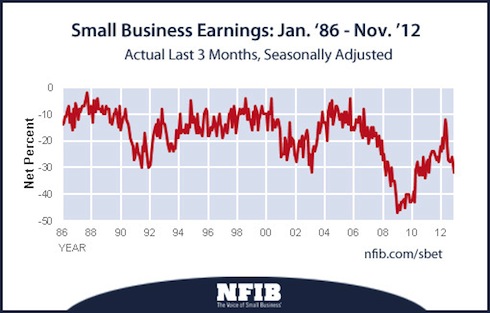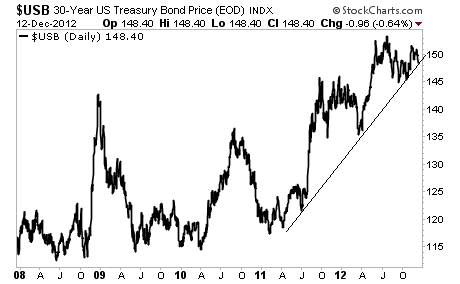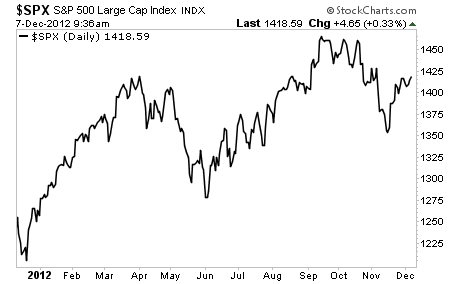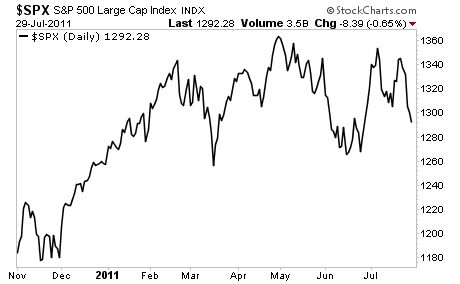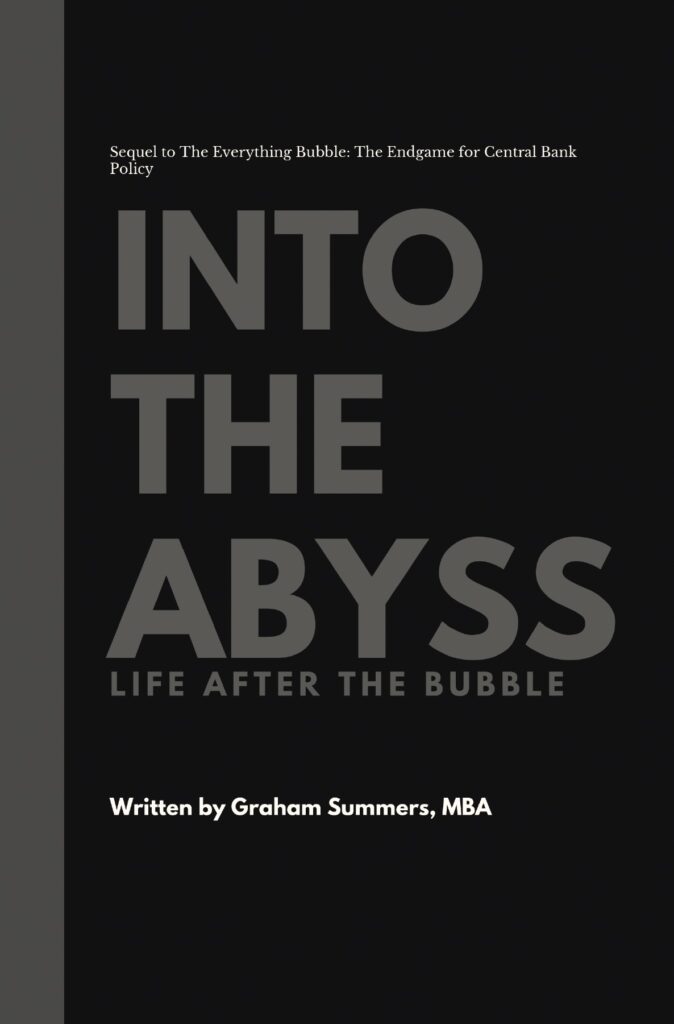The following is an excerpt from the latest issue of Private Wealth Advisory. In it I outline the relationship between the Fed’s commitment to low interest rates, the scramble for high grade collateral driving the sovereign bond markets, and how the whole mess will eventually come crashing down.
Private Wealth Advisory is a bi-weekly market advisory service, providing its readers with expert insights into the global economy and the driving forces behind the financial markets’ moves. To learn more about Private Wealth Advisory… Click Here Now!
The US Fed is committed to keeping interest rates low for the simple fact that if interest rates were to rise then the payments on the debt would send the US into an EU-syle debt crisis along with the commensurate intense austerity measures being implemented.
Unfortunately for the Fed, the bond markets may indeed force this in spite of the Fed’s efforts.
Weimar Germany, like most historic episodes of hyperinflation, occurred when Germany’s Central Bank began monetizing its debts. This worked until the country lost credibility in the international bond markets at which point the Central Bank was forced to monetize everything resulting in a currency collapse and one of the worst episodes of hyperinflation in history.
The US has been moving increasingly down this path which each new QE program. The two reasons the US has not yet entered an inflationary death spiral are:
1) The fact that the US continues to maintain its credibility in the bond markets (at least compared to Europe and Japan).
2) Large financial institutions’ needs for high-grade sovereign bond collateral.
Regarding #1, the US has never defaulted on its debt. Compared to Germany (another safe haven), which has defaulted on its debts twice in the last 100 years, the US remains one of the most credible governments in the world, regardless of how bad the country’s finances are becoming (for now at least).
Regarding the collateral situation, as I’ve explained in recent articles one of the most critical issues in the financial system is the shortage of high grade collateral to backstop the $700 trillion derivatives market.
With France and the ESM bailout fund recently losing their AAA status this issue is only getting worse. The US, despite losing its AAA rated status is still consider high grade due to its having never defaulted on its debt. With that in mind, the Fed decision to take US Treasuries at a time when more and more countries are losing their AAA rated status means that even less high grade collateral will be in the system.
Indeed, as I’ve noted before, because so much of the US debt market is already held by government controlled entities, the Treasuries shortage is even worse than the below article indicates.
Clearinghouses, run by firms such as Chicago-based CME Group (CME) and London-based LCH.Clearnet Group, make traders provide collateral, including government bonds, that can be seized and easily converted into cash to cover defaults. Traders may need from $2 trillion to $4 trillion in extra collateral to meet the new requirements, according to Timothy Keaney, chief executive officer of BNY Mellon Asset Servicing.
The trouble is finding all that high-grade debt. The U.S. had $10.8 trillion in Treasuries outstanding at the end of August. Other countries, including Japan and European nations rated AAA or AA, had about $24 trillion of debt in the second quarter of 2011, according to an April report by the International Monetary Fund. Those government securities are already in heavy demand from central banks and investors.
The solution: At least seven banks plan to let customers swap lower-rated securities that don’t meet standards, in return for a loan of Treasuries or similar holdings that do qualify, a process dubbed “collateral transformation.” The maneuver allows investors who don’t have assets that meet a clearinghouse’s standards to pledge corporate bonds or mortgage-linked securities to a bank in exchange for a loan of Treasuries. The investor then posts the Treasuries—the transformed collateral—to the clearinghouse. The bank earns fees plus interest, and the investor is obliged at some point to return the Treasuries. In effect, the collateral is being rented…
JPMorgan Chase (JPM) and Bank of America (BAC) are already marketing their new collateral-transformation desks, executives at the companies say. Other banks confirmed they’re planning to offer the service too, including Bank of New York Mellon (BK), Barclays (BCS), Deutsche Bank (DB), and State Street (STT).
http://www.businessweek.com/articles/2012-09-20/a-shortage-of-bonds-to-back-derivatives-bets
Here’s the actual amount of Treasuries available to the banks:
| Total US Sovereign Debt | $16 trillion |
| Foreign Nation holdings | $5.4 trillion |
| Intergovernmental holdings | $4.8 trillion |
| US Federal Reserve | $1.5 trillion |
| Remaining | $4.3 trillion |
Indeed, as the below article reveals, the search for high quality collateral is one of the primary items holding up the Treasury market. The Treasury’s latest information reveals that:
Foreign ownership of U.S. Treasury securities rose to a record level in October, a sign that overseas investors remain confident in U.S. debt despite a potential budget crisis.
Total foreign holdings of U.S. Treasurys rose to $5.48 trillion in October, the Treasury Department said Monday. That was up 0.1 percent from September. Still, the increase of $6 billion was the weakest since total holdings fell in December 2011.
China, the largest holder of U.S. government debt, increased its holdings slightly to $1.16 trillion. Japan, the second-largest holder, boosted its holdings by a smaller amount to $1.13 trillion. Brazil, the country with the third-largest holdings, increased its total to $255.2 billion.
My point with all of this is that the search for collateral will drive yields lower… until the bond markets truly begin to spin out of control. In the meantime, the US Fed is playing a very dangerous game by purchasing as many Treasuries as it is. But that game can last much longer than anticipated.
How precisely these issues will finally play out is a mystery. But the consequences will be tremendous. And enormous fortunes will be made by those who get it right. The first key clues will be when Bunds and Treasuries begin to nose dive in a big way.
If you’re an individual investor looking for the means of profiting from all of this… particularly the US going over the fiscal cliff, then you NEED to check out my Private Wealth Advisory newsletter.
Indeed, 78 out of our last 97 trades have made money for Private Wealth Advisory subscribers. That’s an incredible 84% success rate on our investments.
And we’re not getting complacent by any means. In fact, I’m just alerted Private Wealth Advisory subscribers to several trades that will all produce HUGE profits when the US debt implosion picks up steam in the coming weeks.
You’ll find out what they are the minute you subscribe to Private Wealth Advisory. You’ll also gain immediate access to my Protect Your Family, Protect Your Savings, and Protect Your Portfolio Special Reports outlining how to prepare these areas of your life for the coming Great Crisis.
These reports outline:
1) how to prepare for bank holidays
2) which banks to avoid
3) how much bullion to own
4) how much cash is needed to get through systemic crises
5) how much food to stockpile, what kind to get, and where to get it
And more…
To take out an annual subscription to Private Wealth Advisory now… start profiting from the market’s gyrations (again we’ve made money on 78 out of 97 trades in the last 18 months)… and gain access to all my Special Reports…
Best Regards,
Graham Summers




